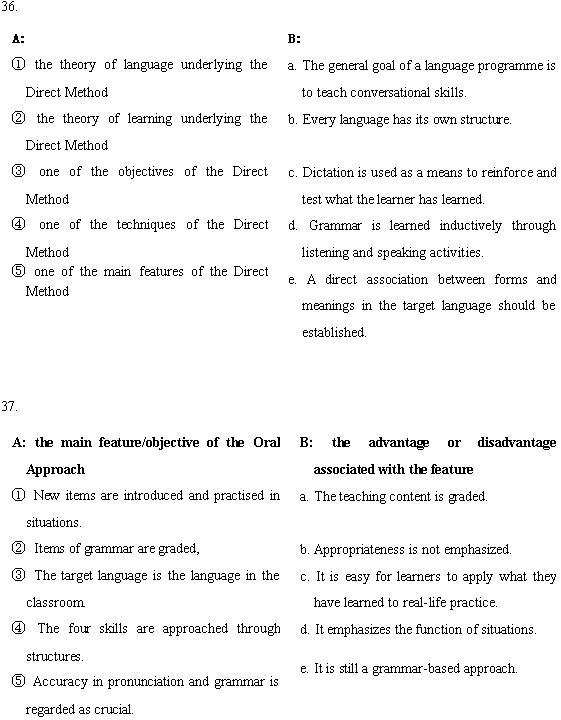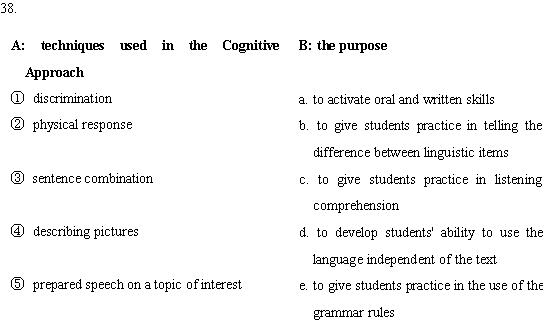全国2008年1月高等教育自学考试外语教学法试题
编辑整理:陕西自考网 发表时间:2018-05-24 06:23:37 字体大小:【大 中 小】
【添加招生老师微信】
《自考视频课程》名师讲解,轻松易懂,助您轻松上岸!低至199元/科!
全国2008年1月高等教育自学考试
外语教学法试题
课程代码:00833
Write all your answers on the Answer Sheet!
I. Multiple Choice: (15%)
Directions: In this section, you are given 15 questions, beneath each of which are four choices marked A, B, C, and D. You are to make the best choice either to complete the incomplete statement or to answer the question. One point is given to each correct choice.
1. The goal of foreign language teaching is to help the student master the ________ language in the shortest possible time.
A. first
B. native
C. target
D. local
2. Franz Boas, an American structuralist, worked at the native languages and cultures of ________.
A. American Indians
B. African Americans
C. European Americans
D. Asian Americans
3. The major focus in a Grammar-Translation classroom is _________.
A. speaking and writing
B. listening and speaking
C. reading and speaking
D. writing and reading
4. The Direct Method emerged as a result of _______ in the 19th century.
A. classroom instruction
B. mass production
C. communicative needs
D. language teaching innovations
5. Which of the following is forbidden in a Direct Method classroom?
A. Using gestures.
B. Sketch drawing.
C. First language.
D. Writing.
6.In his book The Scientific Study and Teaching of Languages (1917), Palmer began with the question, "What is a _______?"
A. language
B. speech
C. sentence
D. word
7. Another name of the Audiolingual Method is ________.
A. speaking approach
B. aural approach
C. listening method
D. aural-oral method
8. The Audiolingual Method considers language ability made up of ________ skills, and these skills can be taught separately.
A. three
B. four
C. five
D. six
9. The generative-transformational school of linguistics emerged through the influence of ________.
A. J.B. Bruner
B. N. Chomsky
C. D. Ausubel
D. G. Kelly
10. The cognitive theory of learning as put forward by Ausubel is perhaps best understood by contrasting rote and _______ learning.
A. useful
B. practical
C. meaningful
D. advanced
11. In Krashen’s view, learning refers to the _______ process leading to the development of competence and is not dependent on the teaching of grammatical rules.
A. conscious
B. unconscious
C. overconscious
D. subconscious
12. The Communicative Approach to foreign language teaching stresses the communicative _______ in learning.
A. competence
B. ability
C. performance
D. skill
13. Sociolinguistic competence refers to an understanding of the ________ in which communication takes place.
A. social behavior
B. linguistic context
C. social context
D. linguistic performance
14. Who is the advocate of the Total Physical Response Method?
A. J. Asher
B.C. Gattegno
C.C.A. Curran
D. G. Lozanov
15. In the 1970s, Krashen’s distinction between language acquisition and language learning and his _______ aroused widespread interest.
A. cognitive theory
B. Monitor Model theory
C. schema theory
D. whole-person learning theory
Ⅱ. Filling Blanks: (20%)
Directions: In this section there are 20 statements with 20 blanks. You are to fill in each blank with ONE appropriate word. One point is given to each blank.
16. According to Gestalt psychology, people tend to perceive objects and scenes as organized ________ first and then their component parts.
17. Jean Piaget stated that as the child grows up, his capacity of ______ would become more and more developed through different stages.
18. With the development of modern languages, Latin gradually became displaced as a ________ language.
19. It was believed by traditional linguists that the _____ form of language was superior to the spoken one.
20. In a Grammar-Translation classroom, the basic unit of language teaching and learning is the _______.
21. The Direct Method believes in the natural process of language learning and in the _________ teaching of grammar.
22. F. Gouin developed an approach to teaching a foreign language on the basis of his observations of child first language learning. In his method new language items were organized and presented in "series" which included sequences of sentences related to ________ in an event.
23. Palmer worked as a teacher of English in Japan for many years, working towards two complementary _________ in English language teaching.
24. The theory of language for the Oral Approach is characteristic of a type of British"_________".
25. Charles Fries applied the principles of ________ linguistics to language teaching.
26. According to behaviorists, the learning model of a language is stimulus-_____ reinforcement.
27. The Cognitive Approach lays emphasis on the conscious acquisition of language as a meaningful ______ and it seeks a basis in cognitive psychology and in transformational grammar.
28. Chomsky maintained that language is not a form of ______. On the contrary, it is an intricate rule-based system and a large part of language acquisition is the learning of this system.
29. The Natural Approach advocates that language teaching should emphasize ______ rather than form.
30. Krashen maintains that acquisition comes about through meaningful ______ in a natural communication setting.
31. Notions are domains in which people use language to express _______ and feeling.
32. ________ is especially interested in the relationships between sentences and the contexts and situations in which they are used.
33. Strategic competence refers to the coping of various strategies which communicators employ to start, end, keep, repair and re-direct _________.
34. The Total Physical Response Method sees successful adult second language learning as a process paralleled to child first language __________.
35. The Silent Way takes a _____________ approach to the organization of language to be taught.
Ⅲ. Matching:(15%)
Directions: This section consists of three groups of pairs listed in two columns A and B. You are to match the one marked ①,②,③,④, or ⑤ in Column A with the one marked a, b, c, d, or e in Column B. One point is given to each pair you match correctly.


IV. Questions for Brief Answers: (30%)
Direction: This section has six questions. You are to briefly answer them. Five points are given to each question.
39. What are the two factors that a foreign language teacher should take into consideration when he/she is to teach?
40. What are the teaching techniques used in the Direct Method?
41. What is the major principle of the Oral Approach?
42. What are the five theoretical principles of the Audiolingual Method?
43. In the Natural Approach, what should a teacher do when the learner is ready to start talking in the target language?
44. There are two major phases in a Suggestopaedia classroom. What are they? And what is the purpose of the second major phase?
V. Questions for Long Answers: (20%)
Directions: The two questions in this section are to be answered on the basis of your own teaching experience as well as the theoretical knowledge you’ve learned. Ten points are given to each question.
45. What teaching method would you like to use in a classic English literature classroom? Towhat extent is this method still desirable in modern language teaching in spite of many attacks on it?
46. Describe the five principles to characterize the Communicative Approach according to David Nunan. Cite one example to illustrate one of these principles.
本文标签:陕西自考历年真题全国2008年1月高等教育自学考试外语教学法试题
转载请注明:文章转载自(http://www.sxzk.sx.cn)

《陕西自考网》免责声明:
1、由于各方面情况的调整与变化,本网提供的考试信息仅供参考,考试信息以省考试院及院校官方发布的信息为准。
2、本网信息来源为其他媒体的稿件转载,免费转载出于非商业性学习目的,版权归原作者所有,如有内容与版权问题等请与本站联系。联系邮箱:812379481@qq.com。





